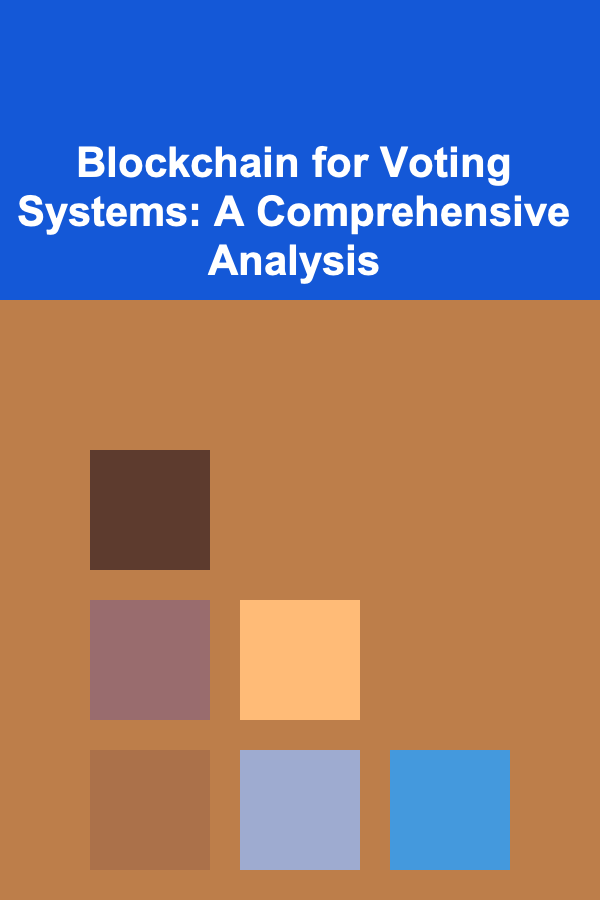
Blockchain for Voting Systems: A Comprehensive Analysis
ebook include PDF & Audio bundle (Micro Guide)
$12.99$9.99
Limited Time Offer! Order within the next:

Introduction: The Promise and Peril of Modern Voting
Democracy, at its core, relies on the integrity and trustworthiness of the voting process. A fundamental tenet of a legitimate government is the ability of its citizens to freely and fairly elect their representatives. However, modern voting systems face increasing challenges, ranging from concerns about voter fraud and manipulation to anxieties surrounding cybersecurity vulnerabilities and accessibility limitations. The complexity of managing voter registration, casting ballots, and counting votes in a transparent and verifiable manner has become a significant burden, particularly in an era of sophisticated cyber threats and increasing public distrust.
Traditional voting methods, often reliant on paper ballots or electronic voting machines, are susceptible to various forms of manipulation and error. Paper ballots can be lost, altered, or duplicated. Electronic voting machines, while offering the potential for efficiency, can be vulnerable to hacking and tampering, leading to doubts about the accuracy of the results. Furthermore, the lack of transparency in many voting processes fuels suspicion and undermines public confidence in the electoral outcome.
Blockchain technology, with its inherent security features and decentralized nature, has emerged as a potential solution to address many of these challenges. Blockchain offers a tamper-proof, transparent, and auditable record of every vote cast, potentially revolutionizing the way elections are conducted. However, implementing blockchain-based voting systems is not without its own set of complexities and challenges. This document will explore the potential benefits and drawbacks of using blockchain technology for voting, examine different approaches to implementation, and analyze the security and privacy considerations involved. It will also address the practical challenges of adoption and the potential impact on voter participation and accessibility.
Understanding Blockchain Technology: A Foundation for Secure Voting
Before delving into the specifics of blockchain voting, it is crucial to understand the underlying technology. Blockchain is, at its simplest, a distributed, immutable ledger that records transactions in a secure and transparent manner. It operates on a peer-to-peer network, where each participant (node) maintains a copy of the blockchain. New transactions are grouped into blocks, which are then cryptographically linked to the previous block, forming a chain.
The key characteristics of blockchain that make it attractive for voting systems include:
- Immutability: Once a block is added to the blockchain, it cannot be altered or deleted. Any attempt to modify a block would require changing all subsequent blocks, which is computationally infeasible due to the cryptographic hash functions used to link the blocks.
- Transparency: All transactions recorded on the blockchain are publicly viewable (although the identities of the parties involved can be anonymized). This allows for independent verification of the voting process.
- Decentralization: The blockchain is not controlled by any single entity. Instead, it is maintained by a distributed network of nodes, making it resistant to censorship and single points of failure.
- Security: Cryptography, including hashing and digital signatures, is used to secure the blockchain and ensure the integrity of the data. Each transaction is signed by the voter's private key, providing authentication and preventing fraud.
- Auditability: The entire history of transactions is recorded on the blockchain, allowing for a complete and verifiable audit trail.
Different types of blockchains exist, each with its own characteristics and use cases. Public blockchains, such as Bitcoin and Ethereum, are open to anyone and allow anyone to participate in the network. Private blockchains, on the other hand, are permissioned and controlled by a specific organization or group of organizations. Consortium blockchains are a hybrid approach, where multiple organizations share control of the network. The choice of blockchain type depends on the specific requirements of the voting system, including the desired level of transparency, security, and control.
Blockchain-Based Voting Systems: Models and Approaches
Several models and approaches for implementing blockchain-based voting systems have been proposed and tested. These approaches differ in their architecture, security mechanisms, and user experience. Here are some of the most prominent models:
3.1 Centralized Voting Platform with Blockchain Audit Trail
In this model, a centralized platform is used for voter registration and ballot casting. However, each vote cast is recorded on a blockchain, providing an immutable and auditable record of the election. This approach leverages the familiar user interface of a centralized system while benefiting from the security and transparency of blockchain.
Advantages:
- Relatively easy to implement and integrate with existing voting infrastructure.
- Provides a clear audit trail for verifying the accuracy of the election results.
- Can improve transparency and public trust in the voting process.
Disadvantages:
- The centralized platform remains a potential point of failure or attack.
- Requires trust in the operator of the centralized platform.
- May not fully address concerns about voter privacy if the centralized platform collects and stores voter data.
3.2 Decentralized Voting Application (DApp)
This model utilizes a fully decentralized application (DApp) built on a blockchain platform. Voters register and cast their ballots directly through the DApp, with all transactions recorded on the blockchain. This approach eliminates the need for a central authority and provides greater transparency and security.
Advantages:
- Eliminates the need for a central authority and reduces the risk of manipulation or censorship.
- Provides a high level of transparency and auditability.
- Can potentially improve voter turnout by making it easier to vote from anywhere with an internet connection.
Disadvantages:
- Can be technically complex to develop and deploy.
- Requires voters to have some familiarity with blockchain technology and cryptocurrency.
- Vulnerable to smart contract vulnerabilities if the DApp is not properly audited.
3.3 Hybrid Approaches
Hybrid approaches combine elements of centralized and decentralized models to create a more robust and flexible voting system. For example, a centralized platform could be used for voter registration, while a decentralized application is used for ballot casting and vote counting.
Advantages:
- Can leverage the strengths of both centralized and decentralized models.
- Allows for greater flexibility in designing the voting system to meet specific needs.
- Can potentially mitigate some of the risks associated with fully centralized or decentralized approaches.
Disadvantages:
- Can be more complex to design and implement than either centralized or decentralized approaches.
- Requires careful consideration of the trade-offs between security, transparency, and usability.
3.4 Considerations for Choosing a Model
The choice of a specific blockchain-based voting model depends on several factors, including:
- The size and complexity of the election: Smaller elections may be better suited to simpler, centralized models, while larger, more complex elections may require a more decentralized approach.
- The level of technical expertise of the voters: If the voters are not familiar with blockchain technology, a simpler, more user-friendly interface may be necessary.
- The available resources and infrastructure: Implementing a blockchain-based voting system can be costly and require significant technical expertise.
- The legal and regulatory environment: The legal and regulatory framework for blockchain-based voting is still evolving in many jurisdictions.
Security and Privacy Considerations
Security and privacy are paramount concerns when implementing any voting system, and blockchain-based systems are no exception. While blockchain offers several inherent security advantages, it is crucial to address potential vulnerabilities and implement appropriate safeguards to protect the integrity of the election and the privacy of the voters.
4.1 Key Security Challenges
- Sybil Attacks: A Sybil attack occurs when an attacker creates multiple fake identities to gain control of the network and manipulate the voting process. To mitigate this risk, strong identity verification mechanisms are necessary to ensure that each voter only has one valid identity.
- 51% Attacks: In a public blockchain, an attacker who controls more than 50% of the network's computing power can potentially manipulate the blockchain and alter the voting results. This risk is less of a concern in private or consortium blockchains, where the number of nodes is limited and controlled.
- Smart Contract Vulnerabilities: If the voting system relies on smart contracts, vulnerabilities in the code could be exploited by attackers to manipulate the voting process. Thorough auditing and testing of smart contracts are essential to prevent such attacks.
- Denial-of-Service (DoS) Attacks: A DoS attack can flood the voting system with traffic, making it unavailable to legitimate voters. To mitigate this risk, robust network security measures are necessary to prevent and mitigate DoS attacks.
- Key Management: Securely managing voter private keys is crucial to prevent unauthorized access to ballots. Poor key management practices can lead to stolen ballots or impersonation.
- Phishing Attacks: Attackers can attempt to steal voter credentials through phishing scams, mimicking legitimate voting websites or applications. Voter education is essential to combat phishing attacks.
4.2 Privacy Considerations
Protecting voter privacy is essential to ensure the integrity and fairness of the election. Blockchain's inherent transparency can pose a challenge to voter privacy, as all transactions are publicly viewable. Several techniques can be used to mitigate this risk, including:
- Zero-Knowledge Proofs: Zero-knowledge proofs allow a voter to prove that they are eligible to vote without revealing their identity or other sensitive information.
- Homomorphic Encryption: Homomorphic encryption allows votes to be tallied without decrypting them, protecting the privacy of individual votes.
- Mixnets: Mixnets shuffle the order of ballots, making it difficult to trace votes back to individual voters.
- Pseudonymization: Replacing voter's real identities with pseudonyms on the blockchain can protect privacy while maintaining the ability to verify eligibility.
It is crucial to carefully consider the privacy implications of different blockchain-based voting models and implement appropriate safeguards to protect voter privacy. Balancing transparency and privacy is a key challenge in designing blockchain-based voting systems.
Practical Challenges and Implementation Considerations
While blockchain technology offers significant potential for improving voting systems, there are several practical challenges that must be addressed before widespread adoption can occur.
5.1 Voter Education and Accessibility
One of the biggest challenges is voter education. Many people are not familiar with blockchain technology and may be hesitant to use a voting system based on it. It is crucial to provide clear and concise information about how the system works and why it is secure and reliable. The user interface must be intuitive and easy to use, even for those with limited technical skills.
Accessibility is another important consideration. The voting system must be accessible to all voters, regardless of their physical abilities, language skills, or access to technology. This may require providing alternative voting methods, such as paper ballots or telephone voting, for those who cannot use the blockchain-based system. Considerations for visually impaired or those with cognitive disabilities are paramount.
5.2 Scalability and Performance
Blockchain networks can be slow and expensive to use, particularly during periods of high traffic. The voting system must be able to handle a large number of transactions quickly and efficiently, without causing delays or errors. This may require using a more scalable blockchain platform or implementing techniques such as sharding or layer-2 scaling solutions.
5.3 Legal and Regulatory Framework
The legal and regulatory framework for blockchain-based voting is still evolving in many jurisdictions. It is crucial to ensure that the voting system complies with all applicable laws and regulations, including those related to voter registration, ballot access, and election security. Clear legal frameworks are needed to define the rights and responsibilities of all stakeholders, including voters, election officials, and blockchain developers.
5.4 Cost and Infrastructure
Implementing a blockchain-based voting system can be costly, requiring significant investment in hardware, software, and technical expertise. It is important to carefully consider the costs and benefits of different approaches and to develop a realistic budget. Existing voting infrastructure may need to be adapted or replaced to accommodate the new system.
5.5 Trust and Public Perception
Public trust is essential for any voting system to be successful. It is crucial to build trust in the blockchain-based system by providing transparency, security, and accountability. Independent audits and certifications can help to build confidence in the system. Addressing public concerns and misconceptions about blockchain technology is crucial for fostering adoption.
Examples of Blockchain Voting Initiatives
Several countries and organizations have experimented with blockchain-based voting systems in recent years. These initiatives provide valuable insights into the potential benefits and challenges of using blockchain for voting.
- Voatz: A mobile voting platform that uses blockchain to secure ballots. It has been used in several small-scale elections in the United States. However, it has also faced security concerns and criticisms regarding its closed-source nature.
- Agora: A blockchain-based voting platform used in local elections in Switzerland. It aims to provide a transparent and auditable voting process.
- Follow My Vote: An open-source blockchain voting platform. They aim to provide secure, transparent, and verifiable elections.
- West Virginia Mobile Voting Pilot: In 2018, West Virginia allowed overseas military personnel to vote using a mobile app secured by blockchain. This pilot program raised significant security concerns due to vulnerabilities identified in the system.
- Estonian e-Residency Program: Estonia, a leader in digital governance, is exploring the use of blockchain for secure and transparent identity verification and potential future voting applications.
These examples highlight the diverse approaches being taken to implement blockchain-based voting systems and the ongoing efforts to address the challenges involved. While some initiatives have faced criticism, they provide valuable lessons for future implementations.
The Future of Blockchain Voting: Opportunities and Challenges
Blockchain technology has the potential to transform voting systems, making them more secure, transparent, and accessible. However, widespread adoption will require addressing the practical challenges and security concerns discussed in this document.
7.1 Potential Benefits
- Increased Security: Blockchain's immutability and cryptographic security can significantly reduce the risk of voter fraud and manipulation.
- Improved Transparency: The transparent nature of blockchain allows for independent verification of the voting process, increasing public trust.
- Enhanced Accessibility: Blockchain-based voting systems can make it easier for people to vote from anywhere in the world, potentially increasing voter turnout.
- Reduced Costs: In the long run, blockchain-based voting systems could potentially reduce the costs associated with traditional voting methods.
- Streamlined Auditing: The immutable ledger provides a clear and verifiable audit trail, simplifying the auditing process and reducing the potential for disputes.
7.2 Key Challenges Moving Forward
- Scalability and Performance: Overcoming the scalability limitations of blockchain networks is crucial for handling large-scale elections.
- Security and Privacy: Addressing security vulnerabilities and protecting voter privacy remains a top priority.
- Voter Education and Accessibility: Ensuring that all voters can easily use and understand the system is essential for widespread adoption.
- Legal and Regulatory Framework: Establishing clear legal and regulatory frameworks for blockchain-based voting is necessary to provide certainty and legitimacy.
- Building Trust: Gaining public trust in the technology and addressing concerns about security and privacy are critical for fostering adoption.
7.3 Conclusion
Blockchain technology offers a promising path towards more secure, transparent, and accessible voting systems. While significant challenges remain, ongoing research and development, combined with careful planning and implementation, can pave the way for a future where blockchain plays a vital role in ensuring the integrity and fairness of democratic elections. Further pilot programs and real-world deployments, coupled with rigorous security audits and public education efforts, are essential for realizing the full potential of blockchain voting. As the technology matures and the legal landscape evolves, blockchain-based voting systems have the potential to revolutionize the way we participate in democracy.
Reading More From Our Other Websites
- [Home Soundproofing 101] How to Reduce Noise Between Rooms in Your House
- [Beachcombing Tip 101] How to Safely Harvest Seaweed for Culinary Use During a Beachcombing Expedition
- [Home Storage Solution 101] How to Use Half Wall Shelving Ideas for Open Concept Living
- [Organization Tip 101] How to Declutter Your Digital Life for Mental Clarity
- [Home Party Planning 101] How to Create a Relaxing, Spa-Inspired Home Party Experience
- [Reading Habit Tip 101] Reading Rituals That Accelerate Self-Discovery and Personal Development
- [Simple Life Tip 101] Best Simplified Financial Planning for Early Retirees
- [Organization Tip 101] How to Deal with Moving-Related Stress and Anxiety
- [Home Rental Property 101] How to Write a Strong Lease Agreement for Your Rental Property
- [Personal Financial Planning 101] How to Manage Your Finances as a Freelancer or Self-Employed Professional

How To Build a Healthy Co-Parenting Relationship
Read More
How to Leverage Remote Work for Career Advancement
Read More
How to Organize Your Digital Files for Easy Access
Read More
How to Set Up a Home Maintenance Schedule
Read More
How to Transform Your Space with Home Depot Artificial Christmas Trees
Read More
Ski Trip Checklist for Backcountry Skiing: Safety First
Read MoreOther Products

How To Build a Healthy Co-Parenting Relationship
Read More
How to Leverage Remote Work for Career Advancement
Read More
How to Organize Your Digital Files for Easy Access
Read More
How to Set Up a Home Maintenance Schedule
Read More
How to Transform Your Space with Home Depot Artificial Christmas Trees
Read More